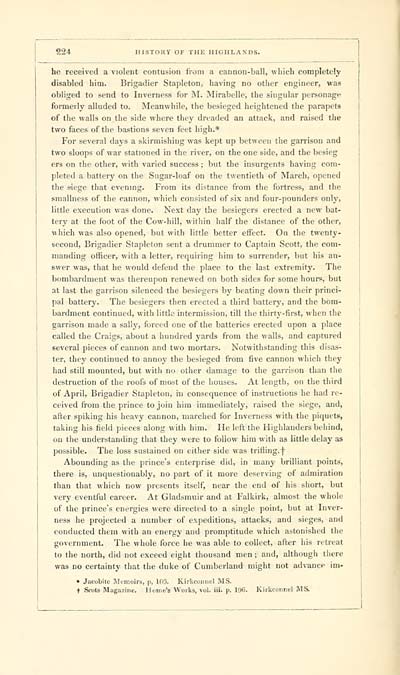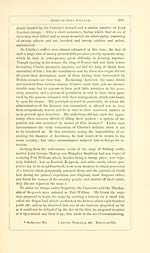Download files
Complete book:
Individual page:
Thumbnail gallery: Grid view | List view

224
HISTORY OF THE HIGHLANDS.
he received a violent contusion from a cannon-ball, wiiich completely
disabled him. Brigadier Stapleton, having no other engineer, was
obliged to send to Inverness for M. Mirabelle, the singular personage
formerly alluded to. Meanwhile, the besieged heightened the parapets
of the walls on the side where they dreaded an attack, and raised the
two faces of the bastions seven feet high.*
For several days a skirmishing was kept up between the garrison and
two sloops of war stationed in the river, on the one side, and the besieg
ers on the other, with varied success ; but the insurgents having com-
pleted a battery on the Sugar-loaf on the twentieth of March, opened
the siege that evening. From its distance from the fortress, and the
smallness of the cannon, which consisted of six and four-pounders only,
little execution was done. Next day the besiegers erected a new bat-
tery at the foot of the Cow-hill, witliin half the distance of the other,
which was also opened, but with little better effect. On the twenty-
second. Brigadier Stapleton sent a drummer to Captain Scott, the com-
manding officer, with a letter, requiring him to surrender, but his an-
swer was, that he would defend the place to the last extremity. The
bombardment was thereupon renewed on both sides for some hours, but
at last the garrison silenced the besiegers by beating down their princi-
pal battery. The besiegers then erected a third battery, and the bom-
bardment continued, with little intermission, till the thirty-first, when the
garrison made a sally, forced one of the batteries erected upon a place
called the Craigs, about a hundred yards from the walls, and captured
several pieces of cannon and two mortars. Notwithstanding this disas-
ter, they continued to annoy the besieged from five cannon which they
had still mounted, but with no other damage to the garrison than the
destruction of the roofs of most of the houses. At length, on the third
of April, Brigadier Stapleton, hi consequence of instructions he had re-
ceived from the prince to join him immediately, raised the siege, and,
after spiking his heavy cannon, marched for Inverness with the piquets,
taking his field pieces along with him. He left the Highlanders behind,
on the understanding that they w ere to follow him with as little delay as
possible. The loss sustained on either side was trifling.f
Abounding as the prince's enterprise did, in many brilliant points,
there is, unquestionably, no part of it more deserving of admiration
than that which now presents itself, near the end of his short, but
very eventful career. At Gladsmuir and at Falkirk, almost the whole
of the prince's energies were directed to a single point, but at Inver-
ness he projected a number of expeditions, attacks, and sieges, and
conducted thein with an energy and promptitude which astonished the
government. The whole force he was able to collect, after his retreat
to the north, did not exceed eight thousand men ; and, although there
was no certainty that the duke of Cumberland might not advance iin-
• Jiutobile IMtnioi
t Scuts Magazine
, p, 103. Kirkconuel MS.
iluiiie'a Works, vol. iii. p. 196.
HISTORY OF THE HIGHLANDS.
he received a violent contusion from a cannon-ball, wiiich completely
disabled him. Brigadier Stapleton, having no other engineer, was
obliged to send to Inverness for M. Mirabelle, the singular personage
formerly alluded to. Meanwhile, the besieged heightened the parapets
of the walls on the side where they dreaded an attack, and raised the
two faces of the bastions seven feet high.*
For several days a skirmishing was kept up between the garrison and
two sloops of war stationed in the river, on the one side, and the besieg
ers on the other, with varied success ; but the insurgents having com-
pleted a battery on the Sugar-loaf on the twentieth of March, opened
the siege that evening. From its distance from the fortress, and the
smallness of the cannon, which consisted of six and four-pounders only,
little execution was done. Next day the besiegers erected a new bat-
tery at the foot of the Cow-hill, witliin half the distance of the other,
which was also opened, but with little better effect. On the twenty-
second. Brigadier Stapleton sent a drummer to Captain Scott, the com-
manding officer, with a letter, requiring him to surrender, but his an-
swer was, that he would defend the place to the last extremity. The
bombardment was thereupon renewed on both sides for some hours, but
at last the garrison silenced the besiegers by beating down their princi-
pal battery. The besiegers then erected a third battery, and the bom-
bardment continued, with little intermission, till the thirty-first, when the
garrison made a sally, forced one of the batteries erected upon a place
called the Craigs, about a hundred yards from the walls, and captured
several pieces of cannon and two mortars. Notwithstanding this disas-
ter, they continued to annoy the besieged from five cannon which they
had still mounted, but with no other damage to the garrison than the
destruction of the roofs of most of the houses. At length, on the third
of April, Brigadier Stapleton, hi consequence of instructions he had re-
ceived from the prince to join him immediately, raised the siege, and,
after spiking his heavy cannon, marched for Inverness with the piquets,
taking his field pieces along with him. He left the Highlanders behind,
on the understanding that they w ere to follow him with as little delay as
possible. The loss sustained on either side was trifling.f
Abounding as the prince's enterprise did, in many brilliant points,
there is, unquestionably, no part of it more deserving of admiration
than that which now presents itself, near the end of his short, but
very eventful career. At Gladsmuir and at Falkirk, almost the whole
of the prince's energies were directed to a single point, but at Inver-
ness he projected a number of expeditions, attacks, and sieges, and
conducted thein with an energy and promptitude which astonished the
government. The whole force he was able to collect, after his retreat
to the north, did not exceed eight thousand men ; and, although there
was no certainty that the duke of Cumberland might not advance iin-
• Jiutobile IMtnioi
t Scuts Magazine
, p, 103. Kirkconuel MS.
iluiiie'a Works, vol. iii. p. 196.
Set display mode to: Large image | Transcription
Images and transcriptions on this page, including medium image downloads, may be used under the Creative Commons Attribution 4.0 International Licence unless otherwise stated. ![]()
| Early Gaelic Book Collections > Ossian Collection > History of the Highlands and of the Highland clans > Volume 3 > (258) |
|---|
| Permanent URL | https://digital.nls.uk/79655518 |
|---|
| Description | Vol. III. |
|---|---|
| Shelfmark | Oss.249 |
| Attribution and copyright: |
|
| Description | Selected books from the Ossian Collection of 327 volumes, originally assembled by J. Norman Methven of Perth. Different editions and translations of James MacPherson's epic poem 'Ossian', some with a map of the 'Kingdom of Connor'. Also secondary material relating to Ossianic poetry and the Ossian controversy. |
|---|
| Description | Selected items from five 'Special and Named Printed Collections'. Includes books in Gaelic and other Celtic languages, works about the Gaels, their languages, literature, culture and history. |
|---|

